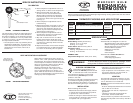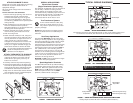
ATTACH SUB-BASE TO WALL
Disconnect the power supply before beginning
installation to prevent electric shock or
equipment damage.
All wiring must comply with local codes and
ordinances.
To wire and mount the thermostat:
1. Pull wires through opening near center of
sub-base and connect wires beneath
terminal screws (See figure 2 for typical
wiring for each application, Also refer to
the following subsections for special system
configurations).
2. Push excess wiring into wall and plug hole
with fire-resistant material (such as
fiberglass insulation) to prevent drafts from
affecting thermostat operation.
3. Position sub-base over hole in wall and
mark mounting hole locations on wall.
4. Drill mounting holes.
5. Fasten sub-base loosely to wall, using two
mounting screws to secure sub-base. Use a
level or plumb line to adjust until level. If
using a plumb line, use the indicator
triangles on the sub-base to level the unit.
If holes in wall are too large and do not
allow you to tighten sub-base snugly, use
plastic screw anchors to secure sub-base.
An incorrectly leveled thermostat will
cause the temperature control to
deviate from the setpoint.
ATTACH THERMOSTAT TO SUB-BASE
1. Remove cover from thermostat base by
gripping the base in one hand. Use the
other hand to pull gently at the top or
bottom of the cover.
2. Carefully remove the protective packing.
3. Attach thermostat base to sub-base, being
sure that all captive screws are tightnened
snugly, since they serve as electrical connec-
tions between thermostat and sub-base.
4. Snap cover on thermostat and set switches
and temperature lever to desired setpoint
5. Turn on power to the system.
SPECIAL APPLICATIONS
Electric Heat Furnaces
(Single Transformer Systems only)
The sub-base, as supplied, may not operate the
fan correctly. If both the heating and the
cooling system must operate the fan relay,
remove the factory-installed jumper wire from
the Y terminal and connect it to the A termi-
nal. The fan should now cycle when the
thermostat calls for either heat or cool.
Two-Transformer Systems
If two transformers are used, they
must be in phase. Failure to do so
may result in personal injury and/or
property damage.
NOTE: Wire color does not indicate polarity.
Polarity is obtained from an oscilloscope or
voltmeter.
Heat Pump Applications
This sub-base WILL NOT provide multi-stage
heating or cooling operation. For single stage
heat pump applications, install a short jumper
wire across terminals W and Y. If the old
thermostat has a terminal that is continuously
energized, disconnect the wire from the old
thermostat’s terminal and connect it either to
the: 1) B terminal, if the reversing valve is
energized on a call for heat; or to the 2) O
terminal, if the reversing valve is energized on
a call for cool. If the system heats on a call for
cool, or vice versa, this wire has been con-
nected to the wrong terminal.
NOTE: RH and RC must be jumpered for single
transformer heat pump systems.
Special Application Terminals
The B and O terminals can provide switching
for special functions other than heat pump
operation. When the system switch is in the
HEAT position, the B terminal is energized.
When the system switch is in the COOL
position, the O terminal is energized.
FIGURE 1 ATTACH THERMOSTAT TO SUB-BASE
Cover
Thermostat
Subbase
FIGURE 2 THERMOSTAT SUB-BASE
TYPICAL WIRING DIAGRAMS
FAN
AUTO ON
SYSTEM
COOL HEAT
OFF
GRC
O
RH
AY
W
B
Yellow Jumper
COMPRESSOR
RELAY
FAN
RELAY
HEAT
RELAY
FIGURE 3 SINGLE TRANSFORMER H/C SYSTEM
For electric heat-fan to cycle with either heat or cool, move yellow jumper from
Y terminal to A terminal (see dotted line at terminal A in illustration.)
FIGURE 4 TWO TRANSFORMER H/C SYSTEM
FAN
AUTO ON
SYSTEM
COOL HEAT
OFF
GRC
O
RH
AY
W
B
COMPRESSOR
RELAY
FAN
RELAY
HEAT
RELAY
FAN
AUTO ON
SYSTEM
COOL HEAT
OFF
GRC
O
RH
AY
W
B
COMPRESSOR
RELAY
FAN
RELAY
Factory Installed
Jumper Wire
Field Installed
Jumper Wire
O*
B**
* O Terminal energized in cooling.
**B Terminal energized in heating.
FIGURE 5 SINGLE TRANSFORMER, SINGLE STAGE HEAT PUMP SYSTEM
Install jumper between W and Y terminals. (See illustration.)
IMPORTANT: Remove factory-installed jumper
between RC and RH terminals for this application.




